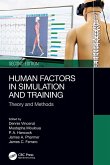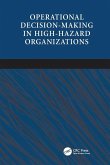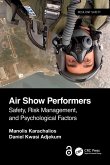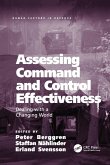Neurocognitive and Physiological Factors During High-Tempo Operations
Herausgeber: Steinberg, Rebecca; Matthews, Michael D.; Kornguth, Steven
Neurocognitive and Physiological Factors During High-Tempo Operations
Herausgeber: Steinberg, Rebecca; Matthews, Michael D.; Kornguth, Steven
- Broschiertes Buch
- Merkliste
- Auf die Merkliste
- Bewerten Bewerten
- Teilen
- Produkt teilen
- Produkterinnerung
- Produkterinnerung
Neurocognitive and Physiological Factors During High-Tempo Operations features world-renowned scientists conducting groundbreaking research into the basic mechanisms of stress effects on the human body and psyche, as well as introducing novel pharmaceutics and equipment that can rescue or improve maximal performance during stress. Its focus is on the military model as an exemplar for high-stress environments, the best for understanding human performance under stress, both in the short-term as well as in the long-term.
Andere Kunden interessierten sich auch für
![Human Factors in Simulation and Training Human Factors in Simulation and Training]() Human Factors in Simulation and Training62,99 €
Human Factors in Simulation and Training62,99 €![Introduction to Human Factors for Organisational Psychologists Introduction to Human Factors for Organisational Psychologists]() Mark W. WigginsIntroduction to Human Factors for Organisational Psychologists64,99 €
Mark W. WigginsIntroduction to Human Factors for Organisational Psychologists64,99 €![Human Factors and Ergonomics in Sport Human Factors and Ergonomics in Sport]() Human Factors and Ergonomics in Sport75,99 €
Human Factors and Ergonomics in Sport75,99 €![Human Factors in Simulation and Training Human Factors in Simulation and Training]() Human Factors in Simulation and Training63,99 €
Human Factors in Simulation and Training63,99 €![Operational Decision-making in High-hazard Organizations Operational Decision-making in High-hazard Organizations]() Jan HayesOperational Decision-making in High-hazard Organizations88,99 €
Jan HayesOperational Decision-making in High-hazard Organizations88,99 €![Air Show Performers Air Show Performers]() Manolis KarachaliosAir Show Performers67,99 €
Manolis KarachaliosAir Show Performers67,99 €![Assessing Command and Control Effectiveness Assessing Command and Control Effectiveness]() Assessing Command and Control Effectiveness91,99 €
Assessing Command and Control Effectiveness91,99 €-
-
-
Neurocognitive and Physiological Factors During High-Tempo Operations features world-renowned scientists conducting groundbreaking research into the basic mechanisms of stress effects on the human body and psyche, as well as introducing novel pharmaceutics and equipment that can rescue or improve maximal performance during stress. Its focus is on the military model as an exemplar for high-stress environments, the best for understanding human performance under stress, both in the short-term as well as in the long-term.
Produktdetails
- Produktdetails
- Verlag: CRC Press
- Seitenzahl: 286
- Erscheinungstermin: 31. März 2017
- Englisch
- Abmessung: 234mm x 156mm x 16mm
- Gewicht: 439g
- ISBN-13: 9781138072725
- ISBN-10: 1138072729
- Artikelnr.: 48093308
- Herstellerkennzeichnung
- Libri GmbH
- Europaallee 1
- 36244 Bad Hersfeld
- gpsr@libri.de
- Verlag: CRC Press
- Seitenzahl: 286
- Erscheinungstermin: 31. März 2017
- Englisch
- Abmessung: 234mm x 156mm x 16mm
- Gewicht: 439g
- ISBN-13: 9781138072725
- ISBN-10: 1138072729
- Artikelnr.: 48093308
- Herstellerkennzeichnung
- Libri GmbH
- Europaallee 1
- 36244 Bad Hersfeld
- gpsr@libri.de
Dr. Steve Kornguth is the Director of the Center for Strategic and Innovative Technologies and Biological and Chemical Defense, Institute for Advanced Technology at The University of Texas at Austin. He is also Professor in the Department of Pharmacy at The University of Texas at Austin and Professor Emeritus in the Departments of Neurology and Biomolecular Chemistry at The University of Wisconsin at Madison. Additionally he is a member of the Army Science Board. Dr. Kornguth's research at Wisconsin related to neural development, autoimmune diseases and development of binding agents and platforms for sensors and magnetic resonance image contrast materials. His research efforts at Austin relate to sustaining high-tempo operations performance of soldiers and developing technologies for defense against biological threats. Dr. Kornguth has also established a team of researchers from UT Austin, Baylor College of Medicine, The US Military Academy, Army Research Laboratory/HRED, and the Iron Horse Brigade (1 BCT) First Brigade Combat Team of the First Cavalry Division, to investigate the physical and cognitive correlates of high-tempo operations activity. This research includes identifying the neurophysiological markers of attentiveness, monitoring brain activity during periods of high and low vigilance, and implementing novel protocols to improve performance in high-tempo environments. Dr. Rebecca Steinberg is Program Manager and Postdoctoral Fellow in the Center for Strategic and Innovative Technologies (CSIT) and the Institute for Advanced Technology (IAT) at the University of Texas at Austin. She oversees and contributes to a multidisciplinary multi-institutional study examining the effects of 36 hours' total sleep deprivation on cognition and physical performance of US military cadets, soldiers, and University of Texas undergraduates. Rebecca publishes a monthly newsletter detailing recent findings in the field of human performance, which can be found online at http://www.csit.utexas.edu/newsletter/newsletter.lasso. Rebecca received her PhD in Neuroscience from the University of Texas at Austin, 2007, with a focus on neuroendocrinology and toxicology/pharmacology. Her dissertation research examined the effects of environmental pollutant exposure across multiple generations using hormone assays, immunocytochemistry, behavior, and gene expression arrays. Dr. Michael D. Matthews is currently Professor of Engineering Psychology at the United States Military Academy, where he serves as Director of the Engineering Psychology Program. He is a former Air Force officer with tours of duty at the US Air Force Human Resources Laboratory and as a faculty member at the US Air Force Academy. Dr. Matthews was selected as a Templeton Foundation Positive Psychology Fellow and much of his research focuses on applying Positive Psychology principles to military contexts. He is on the science advisory board for the Military Child Education Coalition, and served as President of the American Psychological Association's Division of Military Psychology from 2007 to 2008. Collectively, his research interests center on soldier performance in combat and other dangerous contexts.
Contents: Foreword; Introduction, Steve Kornguth; Part 1 Cognition During
Real-World Activities: Promises and challenges in translating
neurofunctional research for army applications, Richard J. Genik II;
Modeling the impact of workload in network centric supervisory control
settings, Mary L. Cummings and C.E. Nehme; Systematic measurements of human
behavior in naturalistic settings, Matthew Rizzo and Joan Severson;
Noninvasive monitoring of brain function with near infrared light, Andrew
K. Dunn. Part 2 Cognition During Sleep Deprivation: Individual differences
to sleep deprivation vulnerability and the neural connection with task
strategy, metacognition, visual spatial attention, and white matter
differences, Matthew Rocklage, W. Todd Maddox, Logan T. Trujillo and David
M. Schnyer; Identification and prediction of substantial differential
vulnerability to the neurobehavioral effects of sleep loss, David F. Dinges
and Namni Goel; Sustaining performance: the other side of sleep, Robert
Stickgold; Factors affecting mnemonic performance in a nonhuman primate
model of cognitive work load, Robert E. Hampson and Sam A. Deadwyler. Part
3 Cognition during Stress and Anxiety: Systems neuroscience approaches to
measure brain mechanisms underlying resilience - towards optimizing
performance, Martin P. Paulus, Alan N. Simmons, Eric G. Potterat, Karl F.
van Orden and Judith L. Swain; The cognitive neuroscience of insight and
its antecedents, John Kounios and Mark Beeman; Decision-making under risk
and stress: developing a testable model, Richard Gonzalez and Israel
Liberzon; Brain processes during expert cognitive-motor performance: the
impact of mental stress and emotion regulation, Bradley D. Hatfield and Amy
J. Haufler. Part 4 Guidance from Military Leadership and Ethical
Considerations: Military operations: humans not machines make the
difference, James L. Merlo; Is supraphysiological enhancement possible, and
what are the downsides?, Karl E. Friedl; The US army future concept for the
human dimension: chief human dimension executive summary, Steven Chandler;
Sustaining performance in mass casualty environments, Annette Sobell;
Neuropsychiatry and aviation safety, Robert R. Ireland; Closing remarks:
realization of existing capabilities in sustaining performance, Rebecca M.
Steinberg, Michael D. Matthews and Steve Kornguth; Index.
Real-World Activities: Promises and challenges in translating
neurofunctional research for army applications, Richard J. Genik II;
Modeling the impact of workload in network centric supervisory control
settings, Mary L. Cummings and C.E. Nehme; Systematic measurements of human
behavior in naturalistic settings, Matthew Rizzo and Joan Severson;
Noninvasive monitoring of brain function with near infrared light, Andrew
K. Dunn. Part 2 Cognition During Sleep Deprivation: Individual differences
to sleep deprivation vulnerability and the neural connection with task
strategy, metacognition, visual spatial attention, and white matter
differences, Matthew Rocklage, W. Todd Maddox, Logan T. Trujillo and David
M. Schnyer; Identification and prediction of substantial differential
vulnerability to the neurobehavioral effects of sleep loss, David F. Dinges
and Namni Goel; Sustaining performance: the other side of sleep, Robert
Stickgold; Factors affecting mnemonic performance in a nonhuman primate
model of cognitive work load, Robert E. Hampson and Sam A. Deadwyler. Part
3 Cognition during Stress and Anxiety: Systems neuroscience approaches to
measure brain mechanisms underlying resilience - towards optimizing
performance, Martin P. Paulus, Alan N. Simmons, Eric G. Potterat, Karl F.
van Orden and Judith L. Swain; The cognitive neuroscience of insight and
its antecedents, John Kounios and Mark Beeman; Decision-making under risk
and stress: developing a testable model, Richard Gonzalez and Israel
Liberzon; Brain processes during expert cognitive-motor performance: the
impact of mental stress and emotion regulation, Bradley D. Hatfield and Amy
J. Haufler. Part 4 Guidance from Military Leadership and Ethical
Considerations: Military operations: humans not machines make the
difference, James L. Merlo; Is supraphysiological enhancement possible, and
what are the downsides?, Karl E. Friedl; The US army future concept for the
human dimension: chief human dimension executive summary, Steven Chandler;
Sustaining performance in mass casualty environments, Annette Sobell;
Neuropsychiatry and aviation safety, Robert R. Ireland; Closing remarks:
realization of existing capabilities in sustaining performance, Rebecca M.
Steinberg, Michael D. Matthews and Steve Kornguth; Index.
Contents: Foreword; Introduction, Steve Kornguth; Part 1 Cognition During
Real-World Activities: Promises and challenges in translating
neurofunctional research for army applications, Richard J. Genik II;
Modeling the impact of workload in network centric supervisory control
settings, Mary L. Cummings and C.E. Nehme; Systematic measurements of human
behavior in naturalistic settings, Matthew Rizzo and Joan Severson;
Noninvasive monitoring of brain function with near infrared light, Andrew
K. Dunn. Part 2 Cognition During Sleep Deprivation: Individual differences
to sleep deprivation vulnerability and the neural connection with task
strategy, metacognition, visual spatial attention, and white matter
differences, Matthew Rocklage, W. Todd Maddox, Logan T. Trujillo and David
M. Schnyer; Identification and prediction of substantial differential
vulnerability to the neurobehavioral effects of sleep loss, David F. Dinges
and Namni Goel; Sustaining performance: the other side of sleep, Robert
Stickgold; Factors affecting mnemonic performance in a nonhuman primate
model of cognitive work load, Robert E. Hampson and Sam A. Deadwyler. Part
3 Cognition during Stress and Anxiety: Systems neuroscience approaches to
measure brain mechanisms underlying resilience - towards optimizing
performance, Martin P. Paulus, Alan N. Simmons, Eric G. Potterat, Karl F.
van Orden and Judith L. Swain; The cognitive neuroscience of insight and
its antecedents, John Kounios and Mark Beeman; Decision-making under risk
and stress: developing a testable model, Richard Gonzalez and Israel
Liberzon; Brain processes during expert cognitive-motor performance: the
impact of mental stress and emotion regulation, Bradley D. Hatfield and Amy
J. Haufler. Part 4 Guidance from Military Leadership and Ethical
Considerations: Military operations: humans not machines make the
difference, James L. Merlo; Is supraphysiological enhancement possible, and
what are the downsides?, Karl E. Friedl; The US army future concept for the
human dimension: chief human dimension executive summary, Steven Chandler;
Sustaining performance in mass casualty environments, Annette Sobell;
Neuropsychiatry and aviation safety, Robert R. Ireland; Closing remarks:
realization of existing capabilities in sustaining performance, Rebecca M.
Steinberg, Michael D. Matthews and Steve Kornguth; Index.
Real-World Activities: Promises and challenges in translating
neurofunctional research for army applications, Richard J. Genik II;
Modeling the impact of workload in network centric supervisory control
settings, Mary L. Cummings and C.E. Nehme; Systematic measurements of human
behavior in naturalistic settings, Matthew Rizzo and Joan Severson;
Noninvasive monitoring of brain function with near infrared light, Andrew
K. Dunn. Part 2 Cognition During Sleep Deprivation: Individual differences
to sleep deprivation vulnerability and the neural connection with task
strategy, metacognition, visual spatial attention, and white matter
differences, Matthew Rocklage, W. Todd Maddox, Logan T. Trujillo and David
M. Schnyer; Identification and prediction of substantial differential
vulnerability to the neurobehavioral effects of sleep loss, David F. Dinges
and Namni Goel; Sustaining performance: the other side of sleep, Robert
Stickgold; Factors affecting mnemonic performance in a nonhuman primate
model of cognitive work load, Robert E. Hampson and Sam A. Deadwyler. Part
3 Cognition during Stress and Anxiety: Systems neuroscience approaches to
measure brain mechanisms underlying resilience - towards optimizing
performance, Martin P. Paulus, Alan N. Simmons, Eric G. Potterat, Karl F.
van Orden and Judith L. Swain; The cognitive neuroscience of insight and
its antecedents, John Kounios and Mark Beeman; Decision-making under risk
and stress: developing a testable model, Richard Gonzalez and Israel
Liberzon; Brain processes during expert cognitive-motor performance: the
impact of mental stress and emotion regulation, Bradley D. Hatfield and Amy
J. Haufler. Part 4 Guidance from Military Leadership and Ethical
Considerations: Military operations: humans not machines make the
difference, James L. Merlo; Is supraphysiological enhancement possible, and
what are the downsides?, Karl E. Friedl; The US army future concept for the
human dimension: chief human dimension executive summary, Steven Chandler;
Sustaining performance in mass casualty environments, Annette Sobell;
Neuropsychiatry and aviation safety, Robert R. Ireland; Closing remarks:
realization of existing capabilities in sustaining performance, Rebecca M.
Steinberg, Michael D. Matthews and Steve Kornguth; Index.









